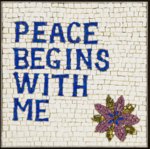


On Oct. 27, 2018, a shooting at the Tree of Life synagogue in Pittsburgh rattled the nation. The attack, among the deadliest against the Jewish community in the history of the United States, left 11 dead and six wounded.
In remembrance, artists across the United States and abroad banded together to create the traveling art exhibit, “From Darkness to Light: Mosaics Inspired by Tragedy.” It is on display at the MSU Main Library through Dec. 22, featuring 34 reproductions of the original 36 mosaics.
Yael Aronoff, director of MSU’s Michael and Elaine Serling Institute for Jewish Studies and Modern Israel, said the exhibit is “a moving tribute by artists from across the world to the 11 congregants of the Tree of Life Synagogue in Pittsburgh four years ago that were murdered as they were praying by an antisemitic white nationalist.”
“I was particularly moved by the reflection in the exhibit by a surviving congregant of the Tree of Life synagogue who was a Holocaust survivor,” Aronoff said. “While we look to the future with hope, it is also daunting that threats and attacks against Jews in the U.S. have risen over the past four years. Two suspects were arrested in New York for threatening a New York City synagogue, one of whom operated a white supremacist Twitter group. This followed an FBI warning of credible threats this month against synagogues in New Jersey. It is our job as educators to educate about these hatreds that lead to murder and other expressions of prejudice.”
Librarian Deborah Margolis worked with Tree of Life board member Dave Kella to bring the exhibit to MSU as a way of highlighting the work of MSU’s Serling Institute for Jewish Studies. Kella serves as the liaison between the mosaic artists and institutions housing the display.
“The institute has been trying to educate the MSU community about antisemitism,” Margolis said. “I thought it would be a good opportunity to support those efforts.”
An art lover herself, Margolis complimented the beauty of the artwork and the recurring themes of positivity, love and peace. She likened mosaics from the exhibit to the concept of taking little pieces from broken things to make something hopeful and beautiful out of our world.
The conception of this collaboration between artists began with mosaic artist Susan Ribnick, owner of Vintage Mosaic in Austin, Texas, and co-president of the Austin Mosaic Guild.
Ribnick called a guild board meeting to create a memorial immediately after the shooting.
“When this happened in Pittsburgh, it just hit very close to home,” she said.
Ribnick has participated in community projects in the past. She believes people can do good work when they are inspired and have something to say.
“When these things happen, everybody walks around feeling kind of helpless and stung. Art can be a very powerful way of getting a message across,” she said.
When speaking about her role in development, Ribnick says she was just the “ringleader” of the project.
The mosaics started as a 12-person intercommunity effort in Austin that quickly grew as more people wanted to get involved. After heavy interest, Ribnick created guidelines and a dedication panel for new collaborators. The number of artists grew to 36 once COVID-19 hit, leaving creatives idle in their studios.
The genesis of the exhibit going on the road was mostly an organic process, according to Ribnick.
“We just started to get invitations. And then, of course, the scope of everything changed,” she said. “We had to get ourselves organized in a different way. I thought it was great. It exceeded my expectations. Because what we’re trying to do is rattle some cages. We’re trying to be heard.” Ribnick held an event in Austin, and after news articles were released, the Skirball Museum in Cincinnati contacted Ribnick about hosting the exhibit. Other venues followed suit.
Displaying the exhibit at MSU’s library is an intentional choice.
“It’s a blend of Jewish and universal symbols and everyone coming together hoping for peace and tolerance,” said Margolis.
A press release described the library as a space that “promotes equal access to information and spaces for all and leads meaningful initiatives in accessibility, diversity, equity and inclusion.”
With daily foot traffic from the MSU community, Margolis shared how refreshing it was seeing the student body experiencing the exhibit.
“I think their initial reaction is just how nice it is,” she said. “Each piece has very different artists; they can read and see what each piece is about and what the exhibit is about as a whole.”
What happens to the message once the exhibit leaves?
“Let the artwork do the heavy lifting,” said Ribnick. “Maybe that will promote a conversation. Rather than walking around feeling indignant and angry, let’s do something.”
“I would like people to continue to learn about different cultures,” Margolis said. “Today, I think many of us do not know people from other cultures, especially other political views. It’s very sad, and that bothers me a lot these days. I hope that people will continue to seek out learning about different people’s views. Maybe there’s something underneath that’s in common.”
Support City Pulse - Donate Today!
Comments
No comments on this item Please log in to comment by clicking here